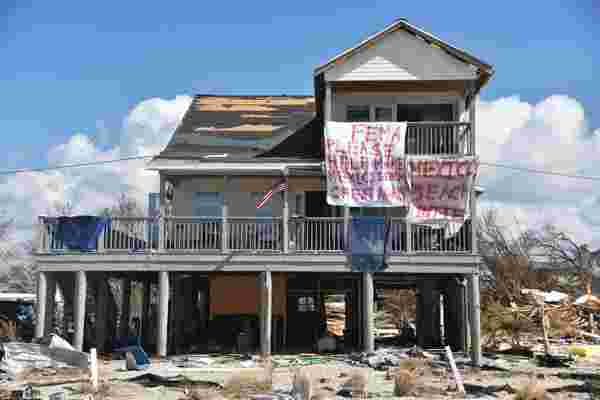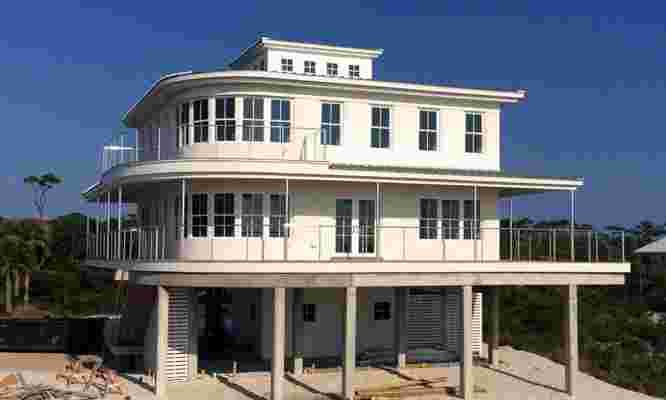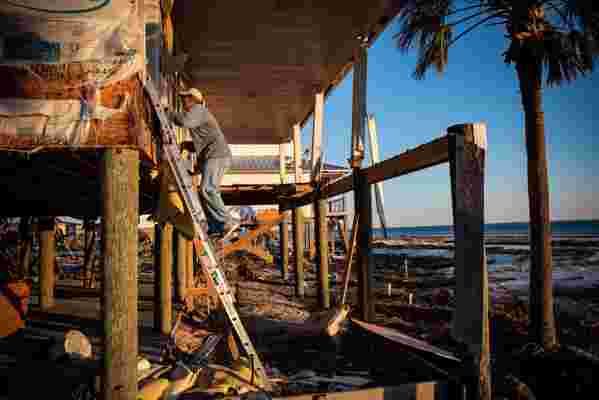The sheer devastation along Florida's Gulf Coast last week—especially in the town of Mexico Beach—was shocking after Hurricane Michael tore through. Along a one-mile stretch of beachfront , three-quarters of the buildings were “destroyed or severely damaged,” according to analysis by The New York Times. Almost as remarkable were the few structures that remained standing.
One such building made it through the Category 4 storm comparatively unscathed. Built to withstand 250-mile-per-hour winds, this house sits on 40-foot pilings that helped keep it above the stormwater surge. An exterior staircase designed to break away in a storm did so, without damaging structural walls. Obviously, these architectural elements did their job.
After Hurricane Andrew, a Category 5 whopper that hit Miami-Dade Country in 1992, building codes for South Florida changed dramatically to ensure structures could withstand hurricane-force winds. But those standards aren't required statewide. Strong hurricanes are rare in the Panhandle; only two have made landfall since 1950, and nothing above Category 3 has ever hit till now. Still, some homeowners in the region had already latched onto the technology and regulations that can make a house virtually hurricane-proof.

A sign that reads "FEMA please help make Mexico Beach great again" is seen on a damaged house in Mexico Beach, Florida. Only a handful of homes remained mostly intact after the storm.
In some Gulf towns, points out designer Ezra Smith, principal of Ezra Smith Designs, entire neighborhoods have been built to such standards. About 20 miles from Mexico Beach, houses like the one Smith designed for his parents on Cape San Blas sustained much less severe damage from the storm, though winds were almost as brutal.
Smith's design called for insulated concrete forms—hollow expanded polystyrene blocks reinforced with plastic tie bars and filled with poured concrete, pilings reinforced with steel rebar and sunk down 20 feet, and aluminum roof cladding. The structure below is wood, and employs hurricane clips and straps to strengthen the framing. For deck overhangs, aluminum pipe with welded flanged tops and bottoms was bolted into the structure to help resist wind uplift. "These followed the aesthetic we were going for, but are also extremely strong," says Smith. Where the house is sited also matters. “They're in the X zone, behind the dunes,” says Smith [whom, it should be noted, this writer knew before reporting this story], referring to area beyond the flood zone. “We didn't have to put the house on pilings, but we did—partly for the view, but also to be higher up.” When Michael came through, the dunes and a nearby park acted as a buffer between the house and the seawater; as a result, neither the neighborhood nor the Smith residence flooded.

The storm-resistant Horizon house, located near Mexico Beach, designed by Ezra Smith Designs.
A house like this will cost more up front to build—likely adding somewhere between 30 and 50 percent of additional cost. Not everyone can afford that, and, of course, many older houses in Mexico Beach were built prior to these technologies being available. But building codes for the region will surely change as they did after Andrew, with the safety of residents and the economic resiliency of the area in mind.
But even if a house can withstand 250-mile-per-hour winds, says Steve Adams, director of urban resilience at the Institute for Sustainable Communities, “it doesn't solve the problem of what you do with the larger infrastructure.” The Smiths' house, for example—like their neighbors' and that lone soldier left in Mexico Beach—is standing, but the peninsula on which it's located reportedly became three distinct islands after the storm. In other words, it's good if your house is still standing, better if you can still get to it, and best if the majority of your community is intact after a megastorm.

A resident of Mexico Beach returns to his family's home after Category 4 Hurricane Michael made landfall. Even if a home can be built to withstand future storms, the question remains: Will the potential collapse of infrastructure warrant such an effort?
Big-picture methods for accomplishing this include ecosystem maintenance (creating or securing wetlands that can absorb floodwaters, using more pervious surfaces, and limiting sprawl, for example) and massive engineering projects (see Rotterdam's storm surge barrier or New Orleans's elaborate system of levees, pumps, and gates ). Rebuilding communities away from storm-prone areas is also possible, but emotional ties—not to mention insurance stipulations for rebuilding—often get in the way. “Retreat would be a logical solution and response, but it's expensive,” comments Adams, who works on projects across the U.S. and Southeast Asia for ISC, and previously worked for the Florida state government on environmental and climate issues. (He also grew up in Panama City, where his 98-year-old dad weathered the recent storm.)
All of these are costly projects that also require political will. On the other hand, one might argue, not adapting or rebuilding communities to withstand increasingly extreme weather will also come at a very steep price. Ultimately, any storm-prone community must ask how it will engineer its way out the problem, or succumb to shortsightedness that will land it in the same predicament again and again. Whatever the answer, says Adams, who now lives in Eugene, Oregon, we'll be “learning to live with water in a different way than we do now.”
RELATED: This Building Material May Hold the Key to Surviving Environmental Disasters
